Project and Operations Management: XYZ Company's Product Launch Plan
VerifiedAdded on 2021/02/08
|19
|4206
|60
Project
AI Summary
This project and operations management assignment analyzes XYZ Company's plan to launch a new product line of big-screen television sets, focusing on the application of project management principles. It begins with an introduction to operations management, including key principles, lean principles, and six sigma methodologies. The assignment then delves into continuous improvement, including a continuous improvement plan, its effectiveness, and strategies for implementation. A significant portion of the assignment is dedicated to the project life cycle, including a business case, project plan, and work breakdown structure. The assignment concludes with a review of the PLC's effectiveness, techniques for cost savings, and implications for both small and large projects, providing a comprehensive overview of project and operations management best practices within the context of XYZ Company's new product launch.
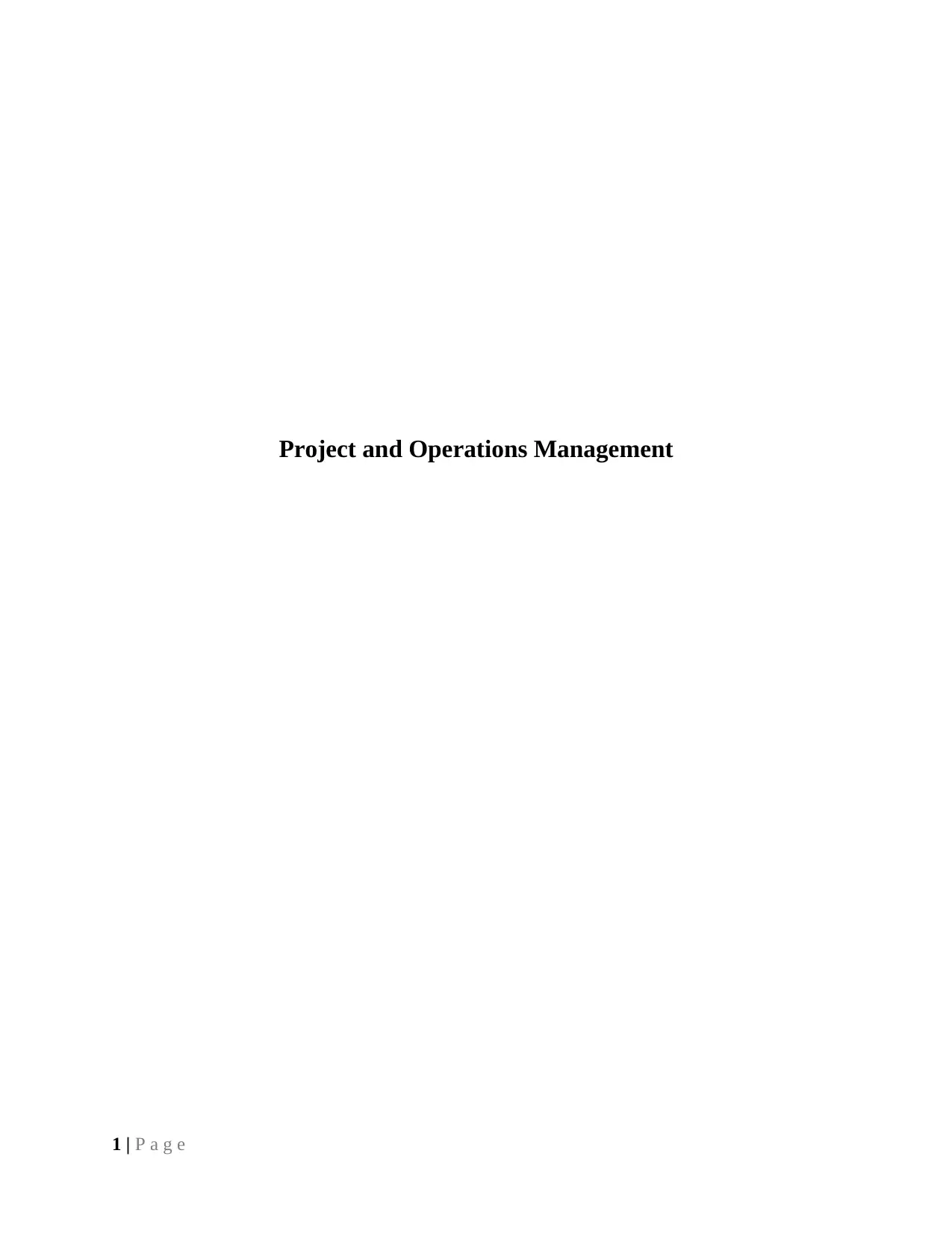
Project and Operations Management
1 | P a g e
1 | P a g e
Paraphrase This Document
Need a fresh take? Get an instant paraphrase of this document with our AI Paraphraser
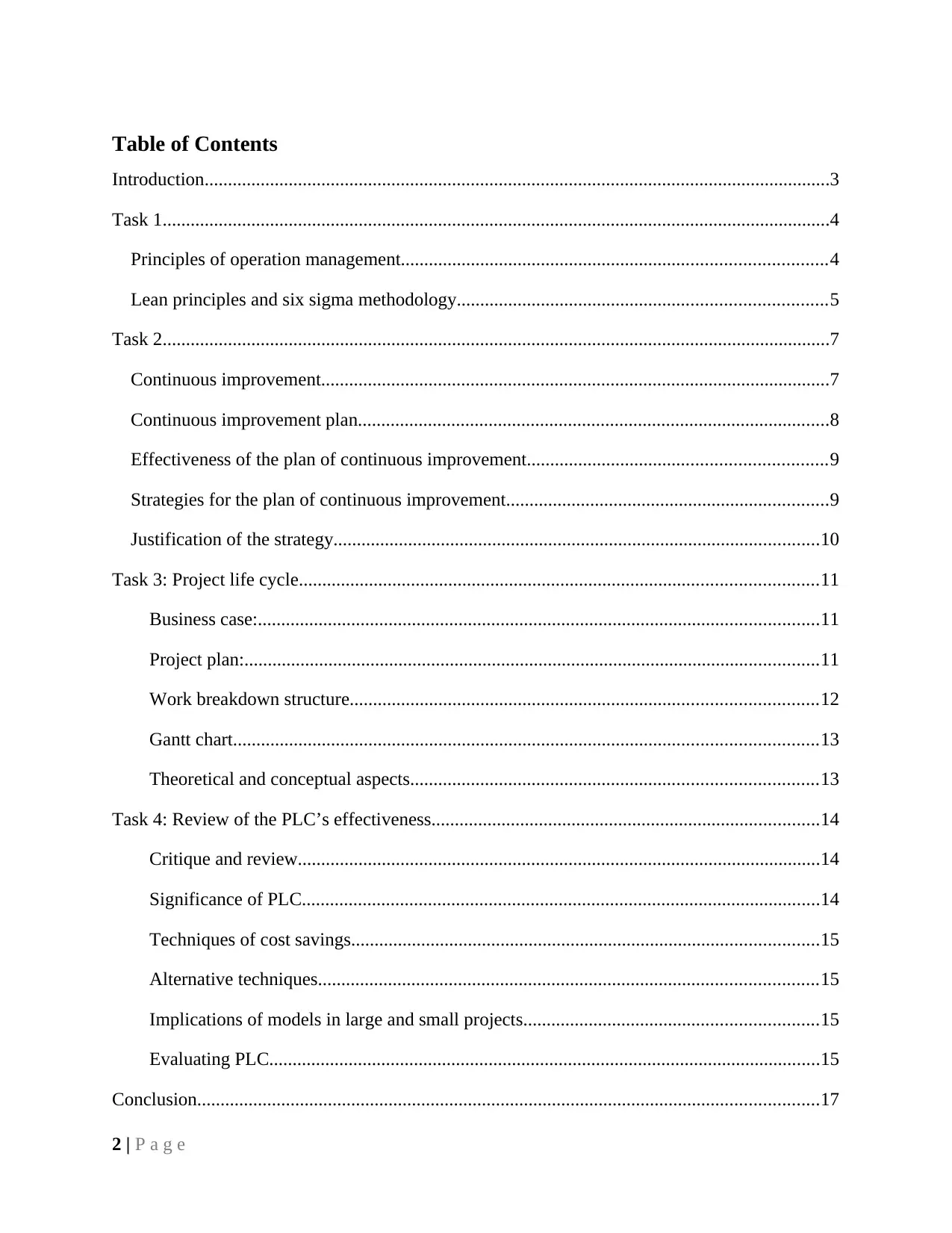
Table of Contents
Introduction......................................................................................................................................3
Task 1...............................................................................................................................................4
Principles of operation management...........................................................................................4
Lean principles and six sigma methodology...............................................................................5
Task 2...............................................................................................................................................7
Continuous improvement.............................................................................................................7
Continuous improvement plan.....................................................................................................8
Effectiveness of the plan of continuous improvement................................................................9
Strategies for the plan of continuous improvement.....................................................................9
Justification of the strategy........................................................................................................10
Task 3: Project life cycle...............................................................................................................11
Business case:........................................................................................................................11
Project plan:...........................................................................................................................11
Work breakdown structure....................................................................................................12
Gantt chart.............................................................................................................................13
Theoretical and conceptual aspects.......................................................................................13
Task 4: Review of the PLC’s effectiveness...................................................................................14
Critique and review................................................................................................................14
Significance of PLC...............................................................................................................14
Techniques of cost savings....................................................................................................15
Alternative techniques...........................................................................................................15
Implications of models in large and small projects...............................................................15
Evaluating PLC......................................................................................................................15
Conclusion.....................................................................................................................................17
2 | P a g e
Introduction......................................................................................................................................3
Task 1...............................................................................................................................................4
Principles of operation management...........................................................................................4
Lean principles and six sigma methodology...............................................................................5
Task 2...............................................................................................................................................7
Continuous improvement.............................................................................................................7
Continuous improvement plan.....................................................................................................8
Effectiveness of the plan of continuous improvement................................................................9
Strategies for the plan of continuous improvement.....................................................................9
Justification of the strategy........................................................................................................10
Task 3: Project life cycle...............................................................................................................11
Business case:........................................................................................................................11
Project plan:...........................................................................................................................11
Work breakdown structure....................................................................................................12
Gantt chart.............................................................................................................................13
Theoretical and conceptual aspects.......................................................................................13
Task 4: Review of the PLC’s effectiveness...................................................................................14
Critique and review................................................................................................................14
Significance of PLC...............................................................................................................14
Techniques of cost savings....................................................................................................15
Alternative techniques...........................................................................................................15
Implications of models in large and small projects...............................................................15
Evaluating PLC......................................................................................................................15
Conclusion.....................................................................................................................................17
2 | P a g e

Bibliography..................................................................................................................................18
3 | P a g e
3 | P a g e
⊘ This is a preview!⊘
Do you want full access?
Subscribe today to unlock all pages.

Trusted by 1+ million students worldwide
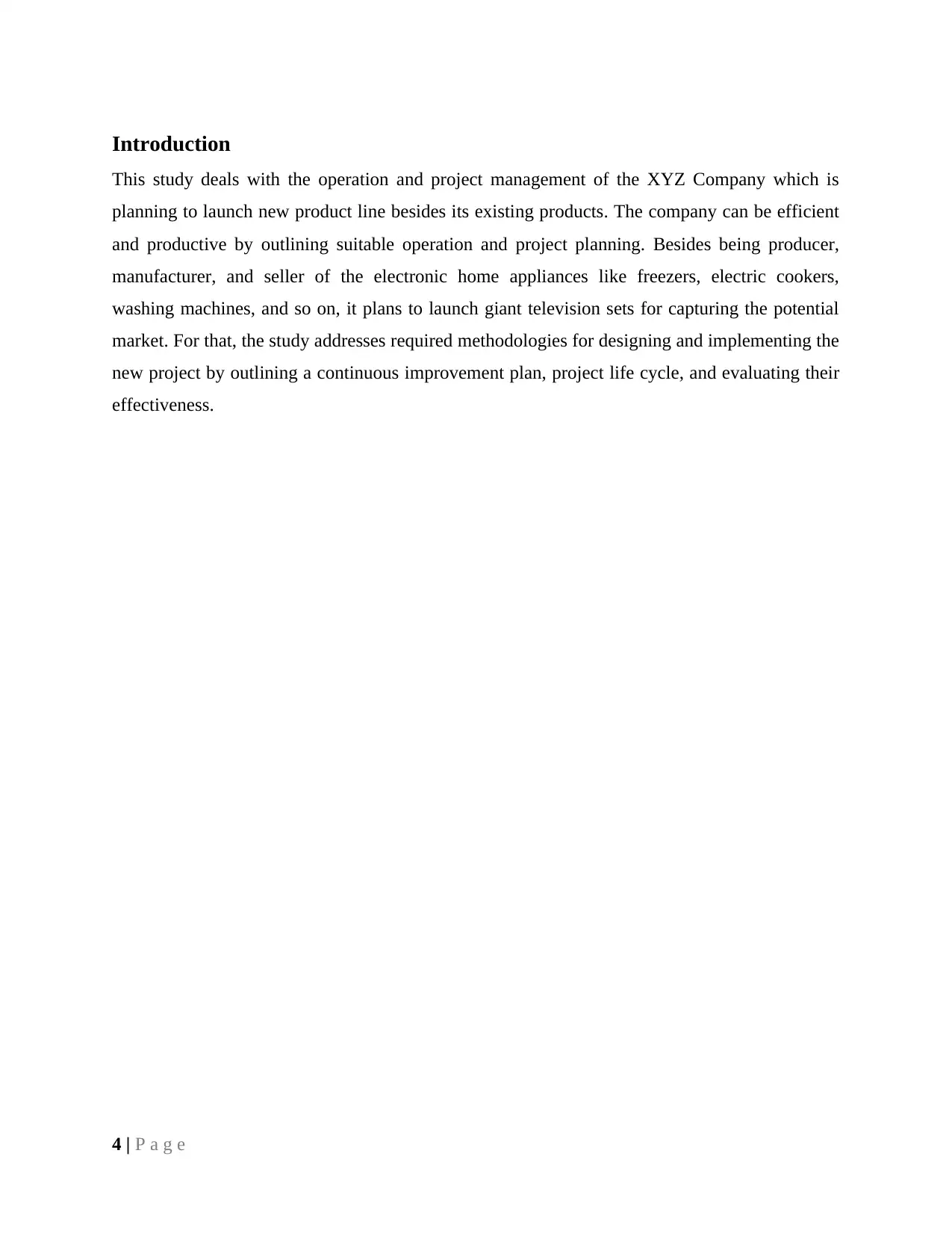
Introduction
This study deals with the operation and project management of the XYZ Company which is
planning to launch new product line besides its existing products. The company can be efficient
and productive by outlining suitable operation and project planning. Besides being producer,
manufacturer, and seller of the electronic home appliances like freezers, electric cookers,
washing machines, and so on, it plans to launch giant television sets for capturing the potential
market. For that, the study addresses required methodologies for designing and implementing the
new project by outlining a continuous improvement plan, project life cycle, and evaluating their
effectiveness.
4 | P a g e
This study deals with the operation and project management of the XYZ Company which is
planning to launch new product line besides its existing products. The company can be efficient
and productive by outlining suitable operation and project planning. Besides being producer,
manufacturer, and seller of the electronic home appliances like freezers, electric cookers,
washing machines, and so on, it plans to launch giant television sets for capturing the potential
market. For that, the study addresses required methodologies for designing and implementing the
new project by outlining a continuous improvement plan, project life cycle, and evaluating their
effectiveness.
4 | P a g e
Paraphrase This Document
Need a fresh take? Get an instant paraphrase of this document with our AI Paraphraser
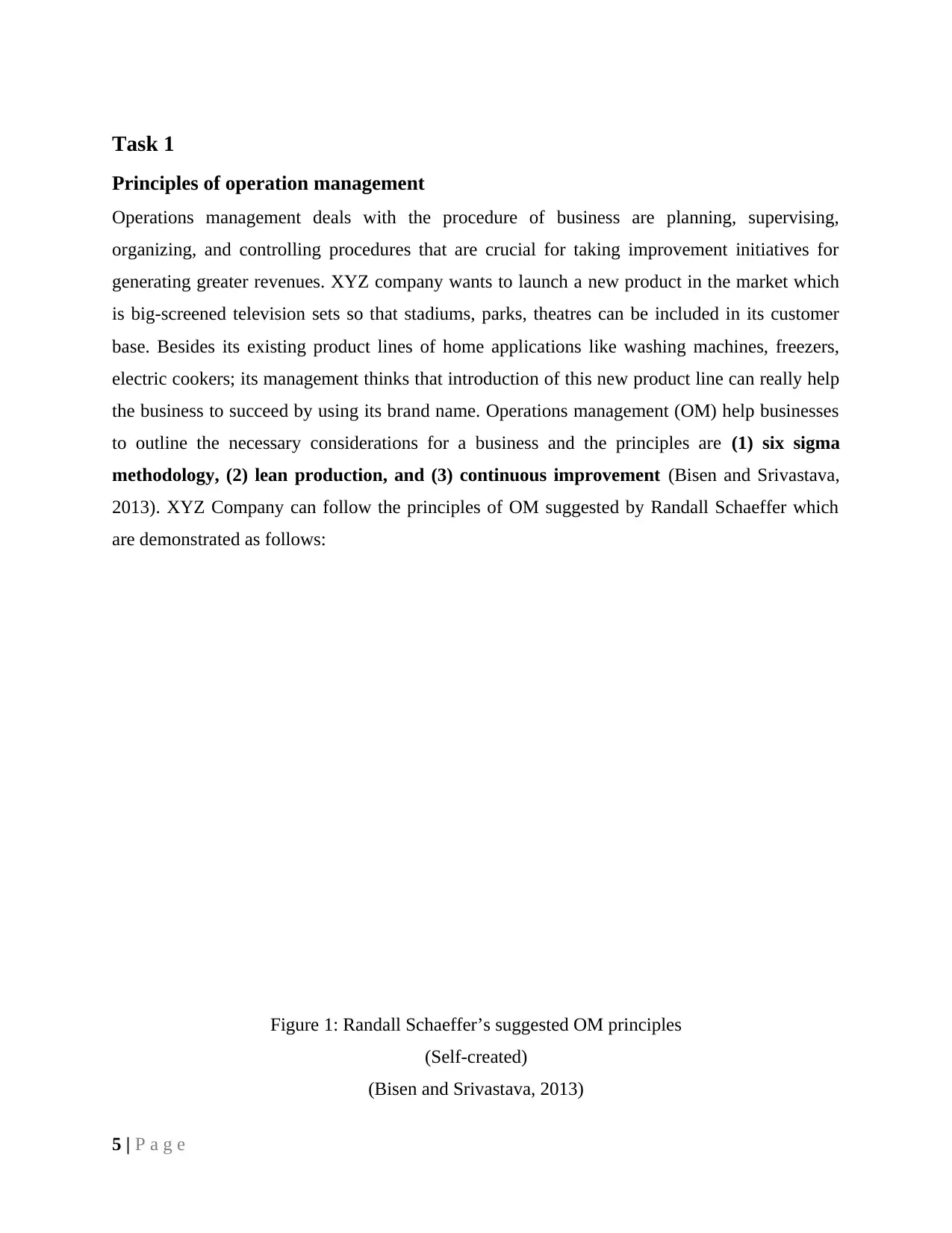
Task 1
Principles of operation management
Operations management deals with the procedure of business are planning, supervising,
organizing, and controlling procedures that are crucial for taking improvement initiatives for
generating greater revenues. XYZ company wants to launch a new product in the market which
is big-screened television sets so that stadiums, parks, theatres can be included in its customer
base. Besides its existing product lines of home applications like washing machines, freezers,
electric cookers; its management thinks that introduction of this new product line can really help
the business to succeed by using its brand name. Operations management (OM) help businesses
to outline the necessary considerations for a business and the principles are (1) six sigma
methodology, (2) lean production, and (3) continuous improvement (Bisen and Srivastava,
2013). XYZ Company can follow the principles of OM suggested by Randall Schaeffer which
are demonstrated as follows:
Figure 1: Randall Schaeffer’s suggested OM principles
(Self-created)
(Bisen and Srivastava, 2013)
5 | P a g e
RealityOrganizatFundamentAccoutabilVariancCausalitHumilitManagedpasSuccessFlexibili
Principles of operation management
Operations management deals with the procedure of business are planning, supervising,
organizing, and controlling procedures that are crucial for taking improvement initiatives for
generating greater revenues. XYZ company wants to launch a new product in the market which
is big-screened television sets so that stadiums, parks, theatres can be included in its customer
base. Besides its existing product lines of home applications like washing machines, freezers,
electric cookers; its management thinks that introduction of this new product line can really help
the business to succeed by using its brand name. Operations management (OM) help businesses
to outline the necessary considerations for a business and the principles are (1) six sigma
methodology, (2) lean production, and (3) continuous improvement (Bisen and Srivastava,
2013). XYZ Company can follow the principles of OM suggested by Randall Schaeffer which
are demonstrated as follows:
Figure 1: Randall Schaeffer’s suggested OM principles
(Self-created)
(Bisen and Srivastava, 2013)
5 | P a g e
RealityOrganizatFundamentAccoutabilVariancCausalitHumilitManagedpasSuccessFlexibili
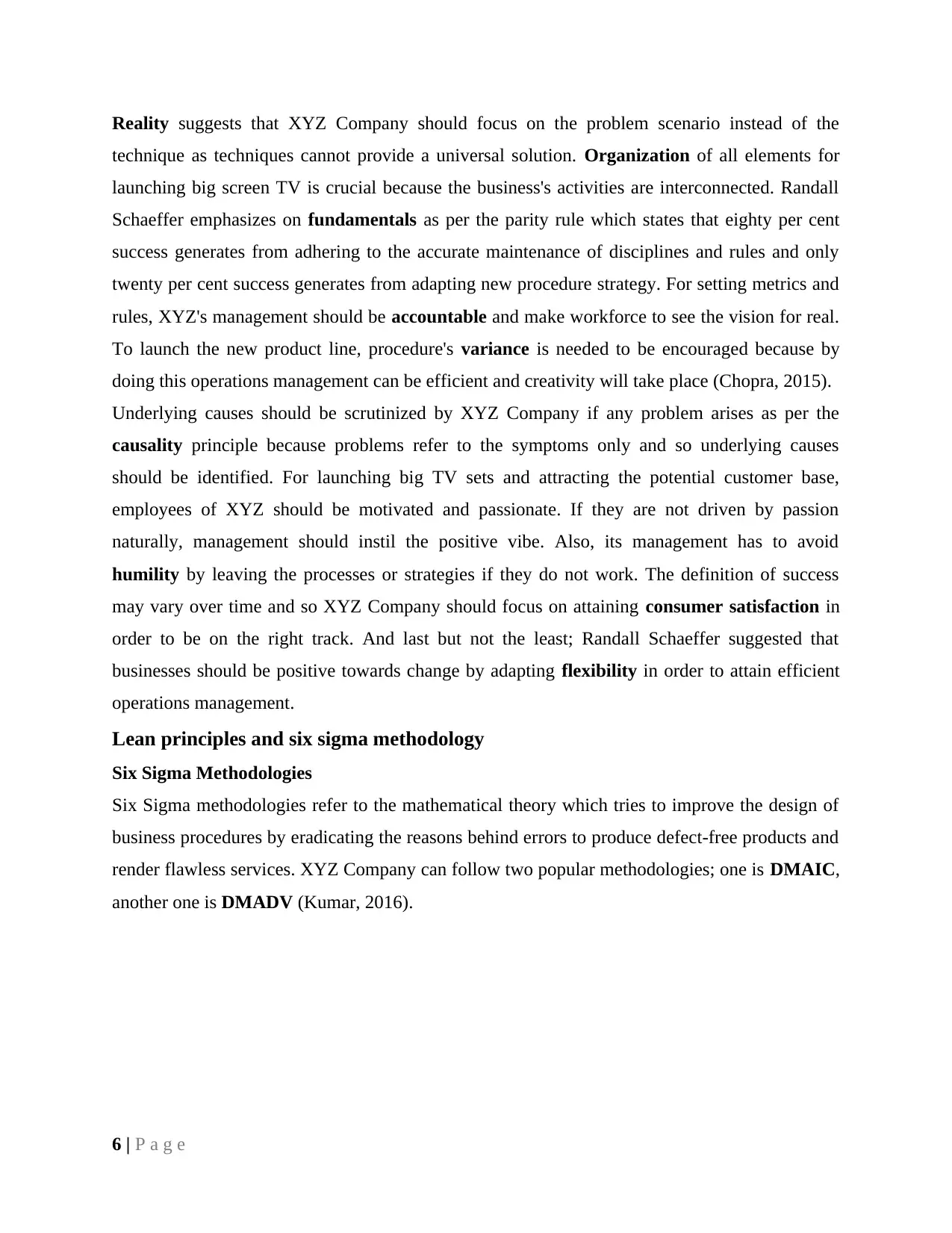
Reality suggests that XYZ Company should focus on the problem scenario instead of the
technique as techniques cannot provide a universal solution. Organization of all elements for
launching big screen TV is crucial because the business's activities are interconnected. Randall
Schaeffer emphasizes on fundamentals as per the parity rule which states that eighty per cent
success generates from adhering to the accurate maintenance of disciplines and rules and only
twenty per cent success generates from adapting new procedure strategy. For setting metrics and
rules, XYZ's management should be accountable and make workforce to see the vision for real.
To launch the new product line, procedure's variance is needed to be encouraged because by
doing this operations management can be efficient and creativity will take place (Chopra, 2015).
Underlying causes should be scrutinized by XYZ Company if any problem arises as per the
causality principle because problems refer to the symptoms only and so underlying causes
should be identified. For launching big TV sets and attracting the potential customer base,
employees of XYZ should be motivated and passionate. If they are not driven by passion
naturally, management should instil the positive vibe. Also, its management has to avoid
humility by leaving the processes or strategies if they do not work. The definition of success
may vary over time and so XYZ Company should focus on attaining consumer satisfaction in
order to be on the right track. And last but not the least; Randall Schaeffer suggested that
businesses should be positive towards change by adapting flexibility in order to attain efficient
operations management.
Lean principles and six sigma methodology
Six Sigma Methodologies
Six Sigma methodologies refer to the mathematical theory which tries to improve the design of
business procedures by eradicating the reasons behind errors to produce defect-free products and
render flawless services. XYZ Company can follow two popular methodologies; one is DMAIC,
another one is DMADV (Kumar, 2016).
6 | P a g e
technique as techniques cannot provide a universal solution. Organization of all elements for
launching big screen TV is crucial because the business's activities are interconnected. Randall
Schaeffer emphasizes on fundamentals as per the parity rule which states that eighty per cent
success generates from adhering to the accurate maintenance of disciplines and rules and only
twenty per cent success generates from adapting new procedure strategy. For setting metrics and
rules, XYZ's management should be accountable and make workforce to see the vision for real.
To launch the new product line, procedure's variance is needed to be encouraged because by
doing this operations management can be efficient and creativity will take place (Chopra, 2015).
Underlying causes should be scrutinized by XYZ Company if any problem arises as per the
causality principle because problems refer to the symptoms only and so underlying causes
should be identified. For launching big TV sets and attracting the potential customer base,
employees of XYZ should be motivated and passionate. If they are not driven by passion
naturally, management should instil the positive vibe. Also, its management has to avoid
humility by leaving the processes or strategies if they do not work. The definition of success
may vary over time and so XYZ Company should focus on attaining consumer satisfaction in
order to be on the right track. And last but not the least; Randall Schaeffer suggested that
businesses should be positive towards change by adapting flexibility in order to attain efficient
operations management.
Lean principles and six sigma methodology
Six Sigma Methodologies
Six Sigma methodologies refer to the mathematical theory which tries to improve the design of
business procedures by eradicating the reasons behind errors to produce defect-free products and
render flawless services. XYZ Company can follow two popular methodologies; one is DMAIC,
another one is DMADV (Kumar, 2016).
6 | P a g e
⊘ This is a preview!⊘
Do you want full access?
Subscribe today to unlock all pages.

Trusted by 1+ million students worldwide
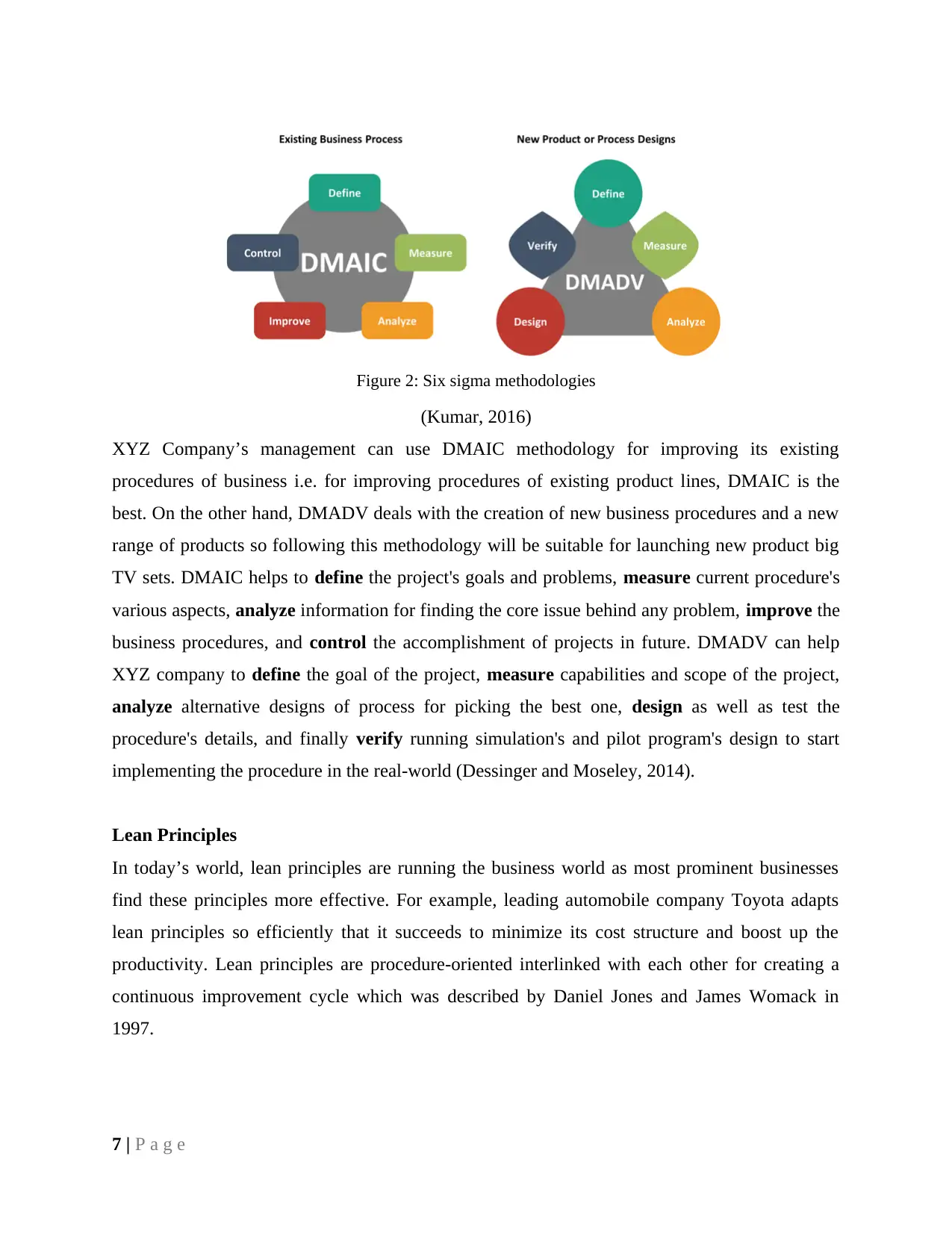
Figure 2: Six sigma methodologies
(Kumar, 2016)
XYZ Company’s management can use DMAIC methodology for improving its existing
procedures of business i.e. for improving procedures of existing product lines, DMAIC is the
best. On the other hand, DMADV deals with the creation of new business procedures and a new
range of products so following this methodology will be suitable for launching new product big
TV sets. DMAIC helps to define the project's goals and problems, measure current procedure's
various aspects, analyze information for finding the core issue behind any problem, improve the
business procedures, and control the accomplishment of projects in future. DMADV can help
XYZ company to define the goal of the project, measure capabilities and scope of the project,
analyze alternative designs of process for picking the best one, design as well as test the
procedure's details, and finally verify running simulation's and pilot program's design to start
implementing the procedure in the real-world (Dessinger and Moseley, 2014).
Lean Principles
In today’s world, lean principles are running the business world as most prominent businesses
find these principles more effective. For example, leading automobile company Toyota adapts
lean principles so efficiently that it succeeds to minimize its cost structure and boost up the
productivity. Lean principles are procedure-oriented interlinked with each other for creating a
continuous improvement cycle which was described by Daniel Jones and James Womack in
1997.
7 | P a g e
(Kumar, 2016)
XYZ Company’s management can use DMAIC methodology for improving its existing
procedures of business i.e. for improving procedures of existing product lines, DMAIC is the
best. On the other hand, DMADV deals with the creation of new business procedures and a new
range of products so following this methodology will be suitable for launching new product big
TV sets. DMAIC helps to define the project's goals and problems, measure current procedure's
various aspects, analyze information for finding the core issue behind any problem, improve the
business procedures, and control the accomplishment of projects in future. DMADV can help
XYZ company to define the goal of the project, measure capabilities and scope of the project,
analyze alternative designs of process for picking the best one, design as well as test the
procedure's details, and finally verify running simulation's and pilot program's design to start
implementing the procedure in the real-world (Dessinger and Moseley, 2014).
Lean Principles
In today’s world, lean principles are running the business world as most prominent businesses
find these principles more effective. For example, leading automobile company Toyota adapts
lean principles so efficiently that it succeeds to minimize its cost structure and boost up the
productivity. Lean principles are procedure-oriented interlinked with each other for creating a
continuous improvement cycle which was described by Daniel Jones and James Womack in
1997.
7 | P a g e
Paraphrase This Document
Need a fresh take? Get an instant paraphrase of this document with our AI Paraphraser
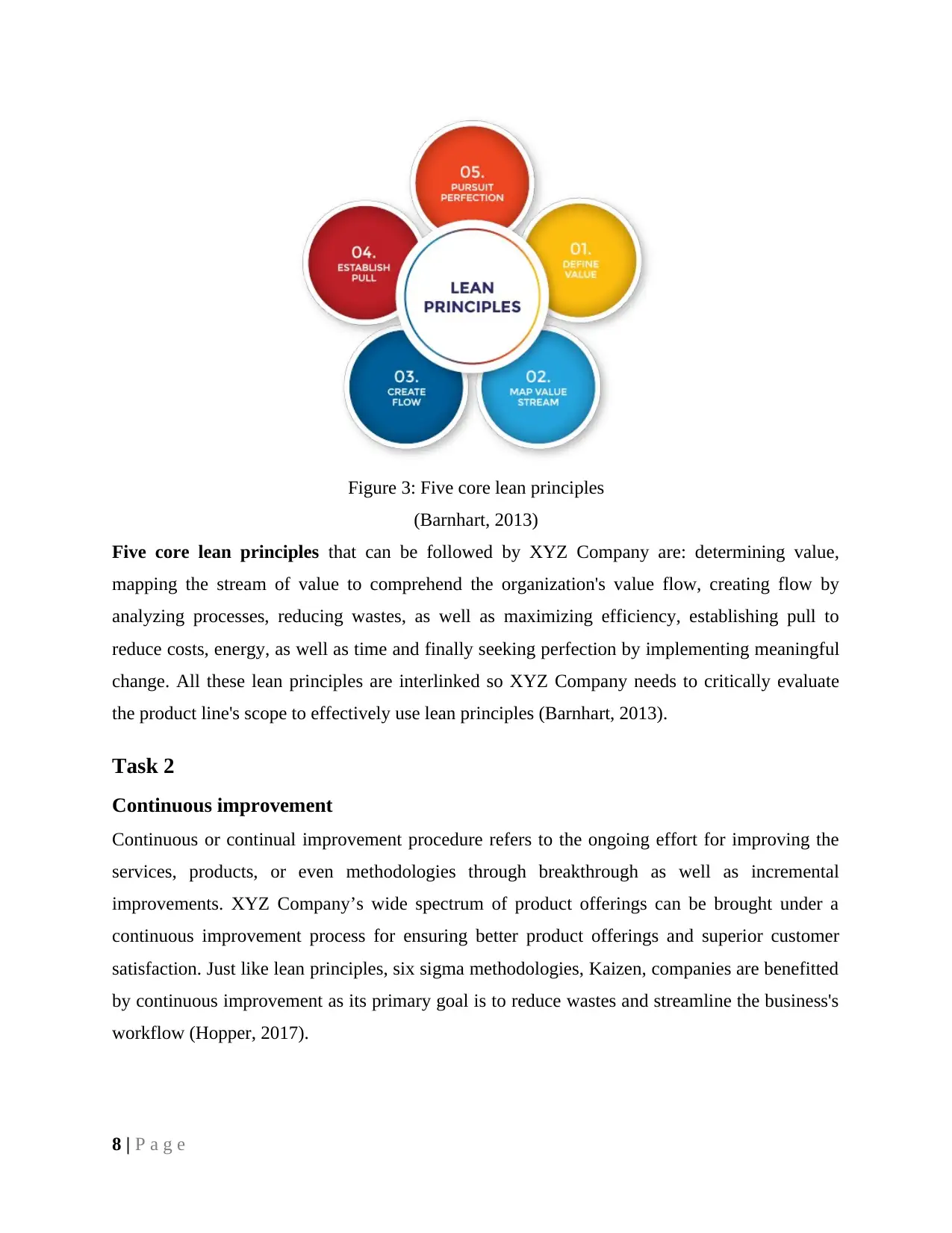
Figure 3: Five core lean principles
(Barnhart, 2013)
Five core lean principles that can be followed by XYZ Company are: determining value,
mapping the stream of value to comprehend the organization's value flow, creating flow by
analyzing processes, reducing wastes, as well as maximizing efficiency, establishing pull to
reduce costs, energy, as well as time and finally seeking perfection by implementing meaningful
change. All these lean principles are interlinked so XYZ Company needs to critically evaluate
the product line's scope to effectively use lean principles (Barnhart, 2013).
Task 2
Continuous improvement
Continuous or continual improvement procedure refers to the ongoing effort for improving the
services, products, or even methodologies through breakthrough as well as incremental
improvements. XYZ Company’s wide spectrum of product offerings can be brought under a
continuous improvement process for ensuring better product offerings and superior customer
satisfaction. Just like lean principles, six sigma methodologies, Kaizen, companies are benefitted
by continuous improvement as its primary goal is to reduce wastes and streamline the business's
workflow (Hopper, 2017).
8 | P a g e
(Barnhart, 2013)
Five core lean principles that can be followed by XYZ Company are: determining value,
mapping the stream of value to comprehend the organization's value flow, creating flow by
analyzing processes, reducing wastes, as well as maximizing efficiency, establishing pull to
reduce costs, energy, as well as time and finally seeking perfection by implementing meaningful
change. All these lean principles are interlinked so XYZ Company needs to critically evaluate
the product line's scope to effectively use lean principles (Barnhart, 2013).
Task 2
Continuous improvement
Continuous or continual improvement procedure refers to the ongoing effort for improving the
services, products, or even methodologies through breakthrough as well as incremental
improvements. XYZ Company’s wide spectrum of product offerings can be brought under a
continuous improvement process for ensuring better product offerings and superior customer
satisfaction. Just like lean principles, six sigma methodologies, Kaizen, companies are benefitted
by continuous improvement as its primary goal is to reduce wastes and streamline the business's
workflow (Hopper, 2017).
8 | P a g e
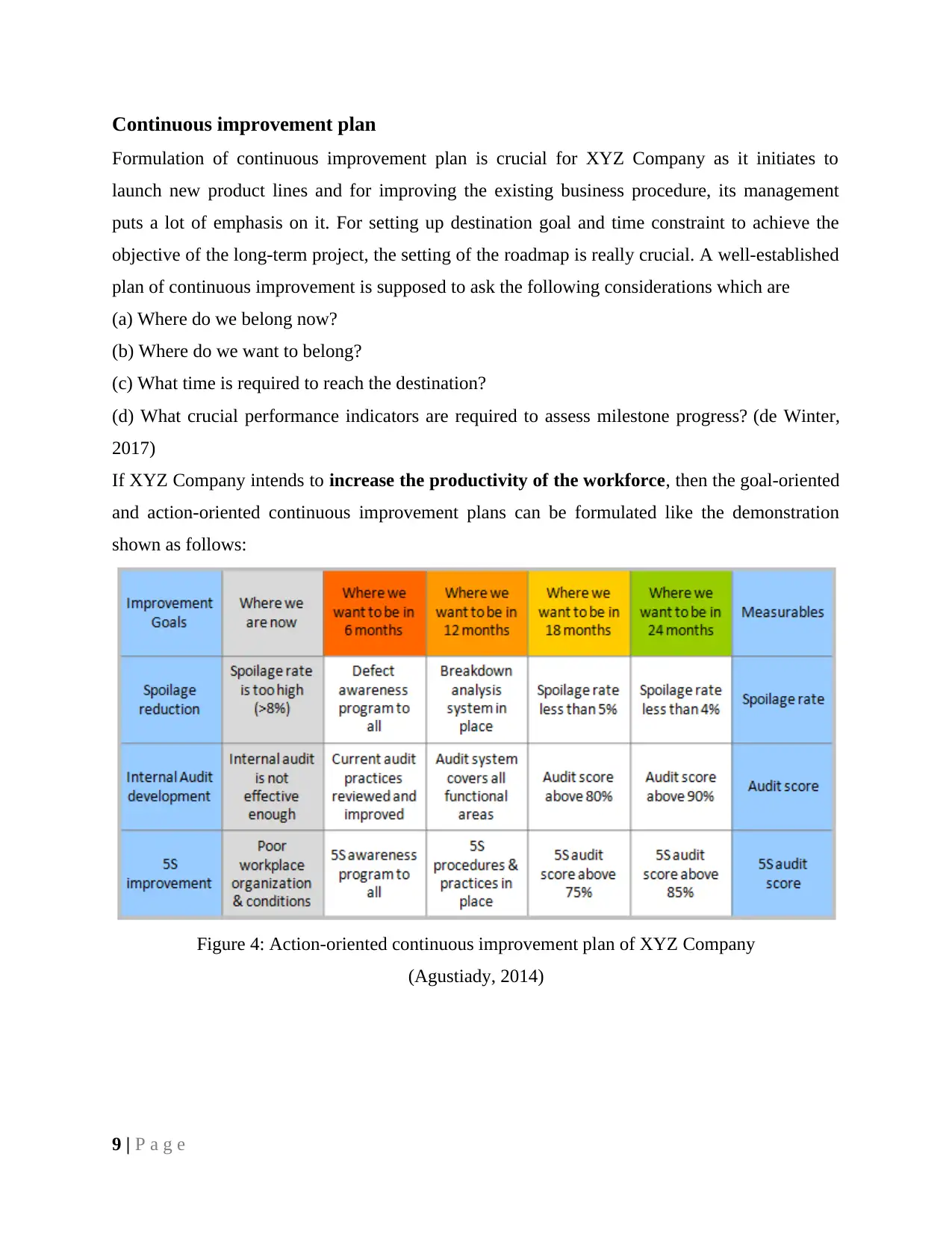
Continuous improvement plan
Formulation of continuous improvement plan is crucial for XYZ Company as it initiates to
launch new product lines and for improving the existing business procedure, its management
puts a lot of emphasis on it. For setting up destination goal and time constraint to achieve the
objective of the long-term project, the setting of the roadmap is really crucial. A well-established
plan of continuous improvement is supposed to ask the following considerations which are
(a) Where do we belong now?
(b) Where do we want to belong?
(c) What time is required to reach the destination?
(d) What crucial performance indicators are required to assess milestone progress? (de Winter,
2017)
If XYZ Company intends to increase the productivity of the workforce, then the goal-oriented
and action-oriented continuous improvement plans can be formulated like the demonstration
shown as follows:
Figure 4: Action-oriented continuous improvement plan of XYZ Company
(Agustiady, 2014)
9 | P a g e
Formulation of continuous improvement plan is crucial for XYZ Company as it initiates to
launch new product lines and for improving the existing business procedure, its management
puts a lot of emphasis on it. For setting up destination goal and time constraint to achieve the
objective of the long-term project, the setting of the roadmap is really crucial. A well-established
plan of continuous improvement is supposed to ask the following considerations which are
(a) Where do we belong now?
(b) Where do we want to belong?
(c) What time is required to reach the destination?
(d) What crucial performance indicators are required to assess milestone progress? (de Winter,
2017)
If XYZ Company intends to increase the productivity of the workforce, then the goal-oriented
and action-oriented continuous improvement plans can be formulated like the demonstration
shown as follows:
Figure 4: Action-oriented continuous improvement plan of XYZ Company
(Agustiady, 2014)
9 | P a g e
⊘ This is a preview!⊘
Do you want full access?
Subscribe today to unlock all pages.

Trusted by 1+ million students worldwide
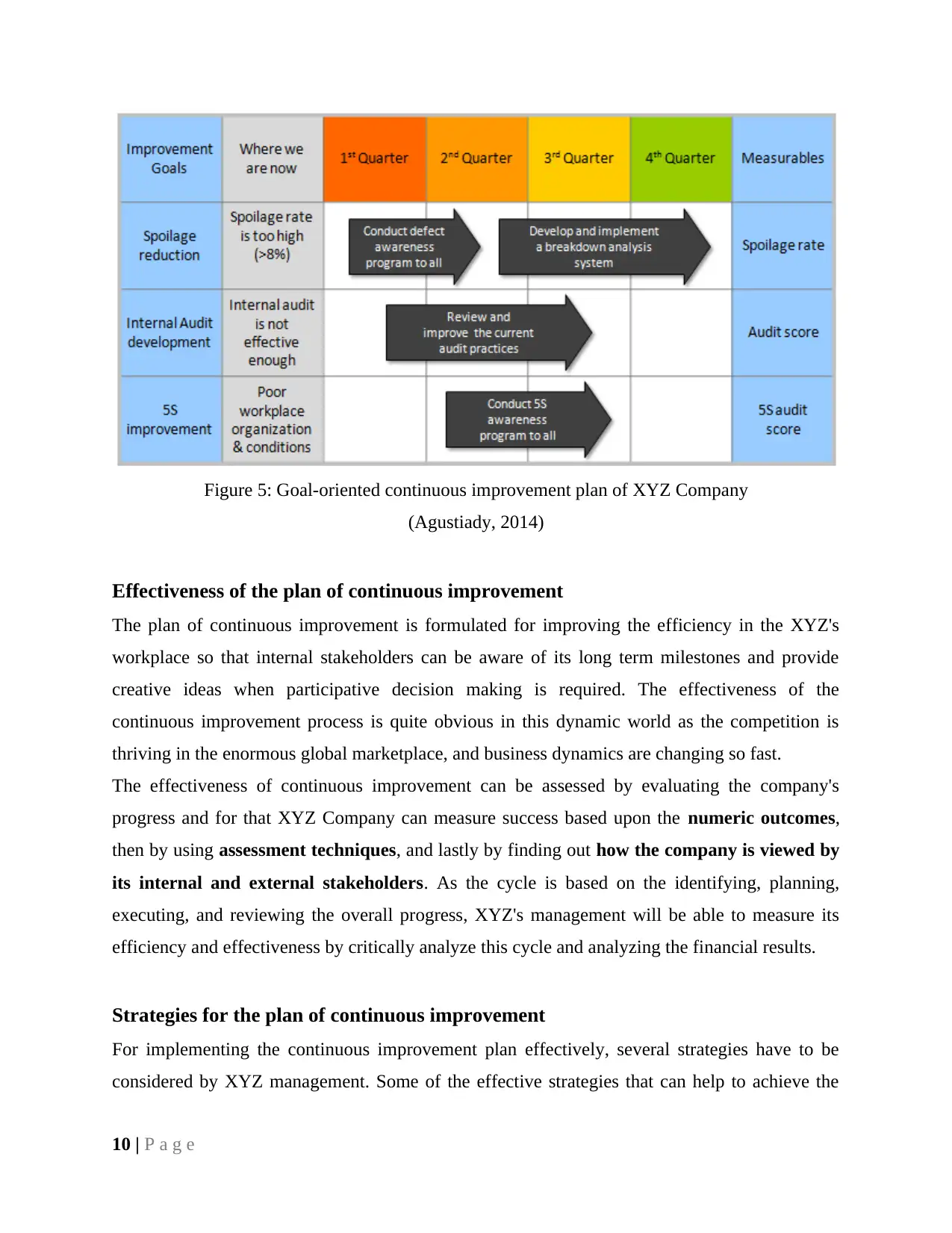
Figure 5: Goal-oriented continuous improvement plan of XYZ Company
(Agustiady, 2014)
Effectiveness of the plan of continuous improvement
The plan of continuous improvement is formulated for improving the efficiency in the XYZ's
workplace so that internal stakeholders can be aware of its long term milestones and provide
creative ideas when participative decision making is required. The effectiveness of the
continuous improvement process is quite obvious in this dynamic world as the competition is
thriving in the enormous global marketplace, and business dynamics are changing so fast.
The effectiveness of continuous improvement can be assessed by evaluating the company's
progress and for that XYZ Company can measure success based upon the numeric outcomes,
then by using assessment techniques, and lastly by finding out how the company is viewed by
its internal and external stakeholders. As the cycle is based on the identifying, planning,
executing, and reviewing the overall progress, XYZ's management will be able to measure its
efficiency and effectiveness by critically analyze this cycle and analyzing the financial results.
Strategies for the plan of continuous improvement
For implementing the continuous improvement plan effectively, several strategies have to be
considered by XYZ management. Some of the effective strategies that can help to achieve the
10 | P a g e
(Agustiady, 2014)
Effectiveness of the plan of continuous improvement
The plan of continuous improvement is formulated for improving the efficiency in the XYZ's
workplace so that internal stakeholders can be aware of its long term milestones and provide
creative ideas when participative decision making is required. The effectiveness of the
continuous improvement process is quite obvious in this dynamic world as the competition is
thriving in the enormous global marketplace, and business dynamics are changing so fast.
The effectiveness of continuous improvement can be assessed by evaluating the company's
progress and for that XYZ Company can measure success based upon the numeric outcomes,
then by using assessment techniques, and lastly by finding out how the company is viewed by
its internal and external stakeholders. As the cycle is based on the identifying, planning,
executing, and reviewing the overall progress, XYZ's management will be able to measure its
efficiency and effectiveness by critically analyze this cycle and analyzing the financial results.
Strategies for the plan of continuous improvement
For implementing the continuous improvement plan effectively, several strategies have to be
considered by XYZ management. Some of the effective strategies that can help to achieve the
10 | P a g e
Paraphrase This Document
Need a fresh take? Get an instant paraphrase of this document with our AI Paraphraser
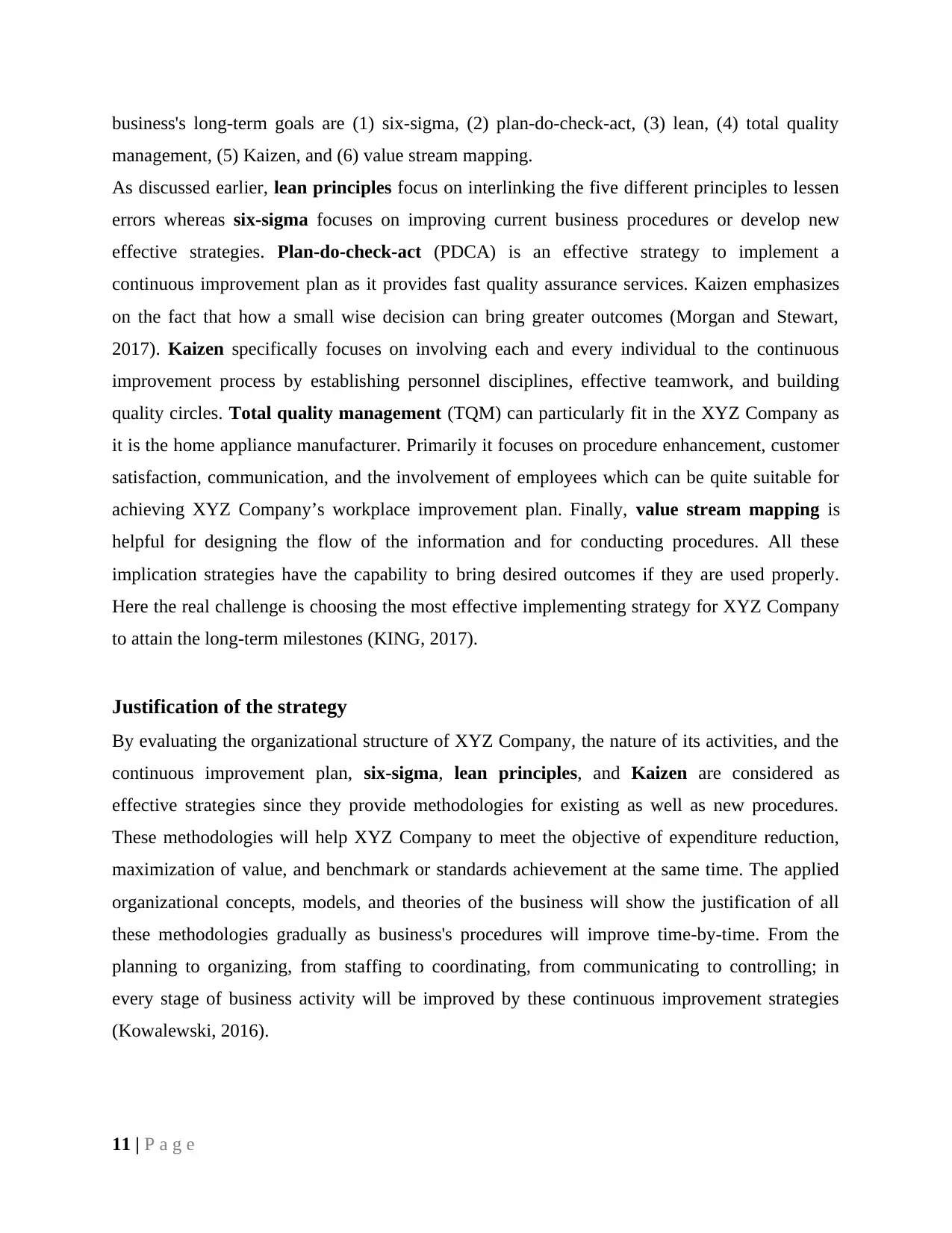
business's long-term goals are (1) six-sigma, (2) plan-do-check-act, (3) lean, (4) total quality
management, (5) Kaizen, and (6) value stream mapping.
As discussed earlier, lean principles focus on interlinking the five different principles to lessen
errors whereas six-sigma focuses on improving current business procedures or develop new
effective strategies. Plan-do-check-act (PDCA) is an effective strategy to implement a
continuous improvement plan as it provides fast quality assurance services. Kaizen emphasizes
on the fact that how a small wise decision can bring greater outcomes (Morgan and Stewart,
2017). Kaizen specifically focuses on involving each and every individual to the continuous
improvement process by establishing personnel disciplines, effective teamwork, and building
quality circles. Total quality management (TQM) can particularly fit in the XYZ Company as
it is the home appliance manufacturer. Primarily it focuses on procedure enhancement, customer
satisfaction, communication, and the involvement of employees which can be quite suitable for
achieving XYZ Company’s workplace improvement plan. Finally, value stream mapping is
helpful for designing the flow of the information and for conducting procedures. All these
implication strategies have the capability to bring desired outcomes if they are used properly.
Here the real challenge is choosing the most effective implementing strategy for XYZ Company
to attain the long-term milestones (KING, 2017).
Justification of the strategy
By evaluating the organizational structure of XYZ Company, the nature of its activities, and the
continuous improvement plan, six-sigma, lean principles, and Kaizen are considered as
effective strategies since they provide methodologies for existing as well as new procedures.
These methodologies will help XYZ Company to meet the objective of expenditure reduction,
maximization of value, and benchmark or standards achievement at the same time. The applied
organizational concepts, models, and theories of the business will show the justification of all
these methodologies gradually as business's procedures will improve time-by-time. From the
planning to organizing, from staffing to coordinating, from communicating to controlling; in
every stage of business activity will be improved by these continuous improvement strategies
(Kowalewski, 2016).
11 | P a g e
management, (5) Kaizen, and (6) value stream mapping.
As discussed earlier, lean principles focus on interlinking the five different principles to lessen
errors whereas six-sigma focuses on improving current business procedures or develop new
effective strategies. Plan-do-check-act (PDCA) is an effective strategy to implement a
continuous improvement plan as it provides fast quality assurance services. Kaizen emphasizes
on the fact that how a small wise decision can bring greater outcomes (Morgan and Stewart,
2017). Kaizen specifically focuses on involving each and every individual to the continuous
improvement process by establishing personnel disciplines, effective teamwork, and building
quality circles. Total quality management (TQM) can particularly fit in the XYZ Company as
it is the home appliance manufacturer. Primarily it focuses on procedure enhancement, customer
satisfaction, communication, and the involvement of employees which can be quite suitable for
achieving XYZ Company’s workplace improvement plan. Finally, value stream mapping is
helpful for designing the flow of the information and for conducting procedures. All these
implication strategies have the capability to bring desired outcomes if they are used properly.
Here the real challenge is choosing the most effective implementing strategy for XYZ Company
to attain the long-term milestones (KING, 2017).
Justification of the strategy
By evaluating the organizational structure of XYZ Company, the nature of its activities, and the
continuous improvement plan, six-sigma, lean principles, and Kaizen are considered as
effective strategies since they provide methodologies for existing as well as new procedures.
These methodologies will help XYZ Company to meet the objective of expenditure reduction,
maximization of value, and benchmark or standards achievement at the same time. The applied
organizational concepts, models, and theories of the business will show the justification of all
these methodologies gradually as business's procedures will improve time-by-time. From the
planning to organizing, from staffing to coordinating, from communicating to controlling; in
every stage of business activity will be improved by these continuous improvement strategies
(Kowalewski, 2016).
11 | P a g e
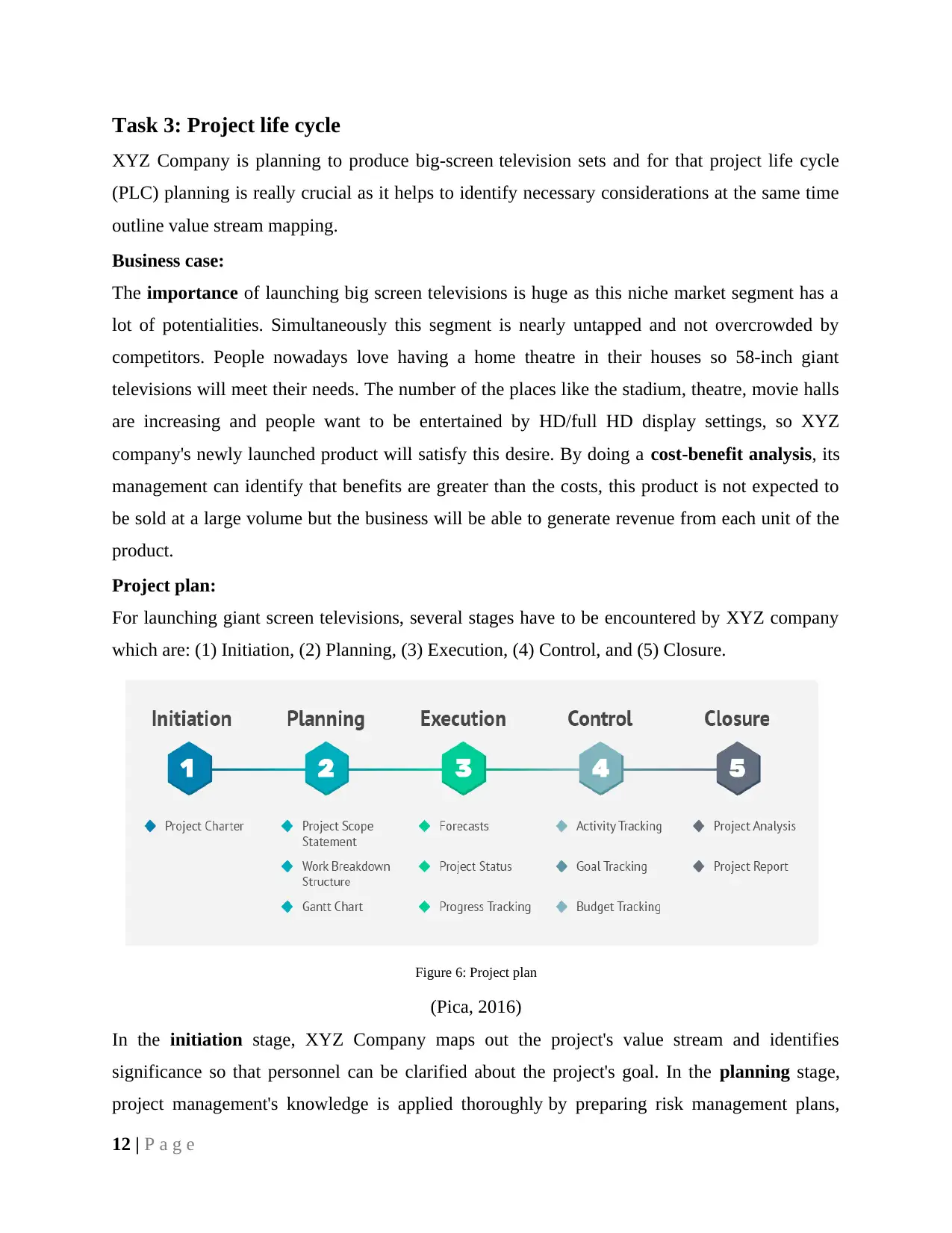
Task 3: Project life cycle
XYZ Company is planning to produce big-screen television sets and for that project life cycle
(PLC) planning is really crucial as it helps to identify necessary considerations at the same time
outline value stream mapping.
Business case:
The importance of launching big screen televisions is huge as this niche market segment has a
lot of potentialities. Simultaneously this segment is nearly untapped and not overcrowded by
competitors. People nowadays love having a home theatre in their houses so 58-inch giant
televisions will meet their needs. The number of the places like the stadium, theatre, movie halls
are increasing and people want to be entertained by HD/full HD display settings, so XYZ
company's newly launched product will satisfy this desire. By doing a cost-benefit analysis, its
management can identify that benefits are greater than the costs, this product is not expected to
be sold at a large volume but the business will be able to generate revenue from each unit of the
product.
Project plan:
For launching giant screen televisions, several stages have to be encountered by XYZ company
which are: (1) Initiation, (2) Planning, (3) Execution, (4) Control, and (5) Closure.
Figure 6: Project plan
(Pica, 2016)
In the initiation stage, XYZ Company maps out the project's value stream and identifies
significance so that personnel can be clarified about the project's goal. In the planning stage,
project management's knowledge is applied thoroughly by preparing risk management plans,
12 | P a g e
XYZ Company is planning to produce big-screen television sets and for that project life cycle
(PLC) planning is really crucial as it helps to identify necessary considerations at the same time
outline value stream mapping.
Business case:
The importance of launching big screen televisions is huge as this niche market segment has a
lot of potentialities. Simultaneously this segment is nearly untapped and not overcrowded by
competitors. People nowadays love having a home theatre in their houses so 58-inch giant
televisions will meet their needs. The number of the places like the stadium, theatre, movie halls
are increasing and people want to be entertained by HD/full HD display settings, so XYZ
company's newly launched product will satisfy this desire. By doing a cost-benefit analysis, its
management can identify that benefits are greater than the costs, this product is not expected to
be sold at a large volume but the business will be able to generate revenue from each unit of the
product.
Project plan:
For launching giant screen televisions, several stages have to be encountered by XYZ company
which are: (1) Initiation, (2) Planning, (3) Execution, (4) Control, and (5) Closure.
Figure 6: Project plan
(Pica, 2016)
In the initiation stage, XYZ Company maps out the project's value stream and identifies
significance so that personnel can be clarified about the project's goal. In the planning stage,
project management's knowledge is applied thoroughly by preparing risk management plans,
12 | P a g e
⊘ This is a preview!⊘
Do you want full access?
Subscribe today to unlock all pages.

Trusted by 1+ million students worldwide
1 out of 19
Related Documents
Your All-in-One AI-Powered Toolkit for Academic Success.
+13062052269
info@desklib.com
Available 24*7 on WhatsApp / Email
![[object Object]](/_next/static/media/star-bottom.7253800d.svg)
Unlock your academic potential
Copyright © 2020–2025 A2Z Services. All Rights Reserved. Developed and managed by ZUCOL.





